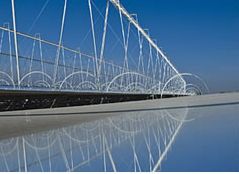
The new plant is being lauded as the first solar thermal installation to begin generating electricity in California in 20 years, but it is also many times smaller than the plants that will be considered standard in the future. To be specific, it will generate about 35 times less power than Ausra’s own planned 177MW plant that will be constructed nearby in San Luis Obispo County, and a string of similar installations will be built by Brightsource for a total of 900MW.
[aditude-amp id="flyingcarpet" targeting='{"env":"staging","page_type":"article","post_id":99529,"post_type":"story","post_chan":"none","tags":null,"ai":false,"category":"none","all_categories":"enterprise,","session":"A"}']Plants in the range of the 5MW installation won’t be unknown either, though. They’ll just be used for different purposes. A number of companies are looking at (relatively) small-scale solar thermal lines to generate steam for industrial processes. ESolar has told me it’s planning to roll out small modular plants for that purpose, and on an even smaller scale, Sopogy can use miniature solar-thermal dishes for heating and cooling large buildings. There’s more on those alternate uses at Green Wombat.
For the moment, it doesn’t look like the credit crunch is delaying plans for larger, utility-scale deployments of 50MW and upward, at least according to what company execs have told me. Most plants haven’t yet begun construction, and can spend time locating funding sources during permitting, while others have already secured debt or equity money to build. However, an extended recession could trim the number of plants that go online over the next four to five years.
VentureBeat's mission is to be a digital town square for technical decision-makers to gain knowledge about transformative enterprise technology and transact. Learn More
